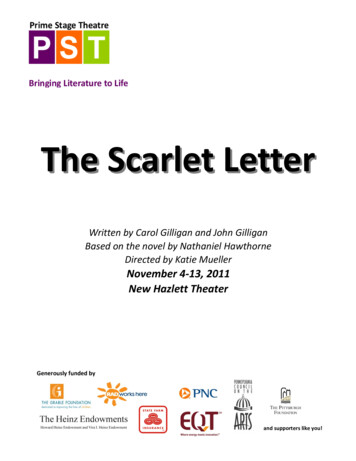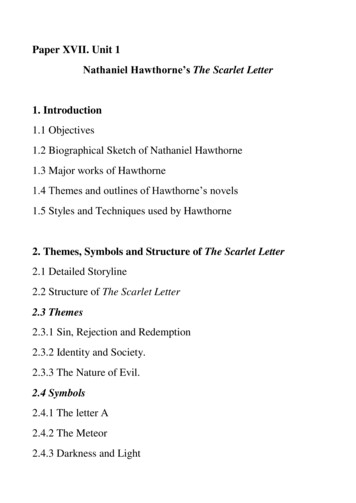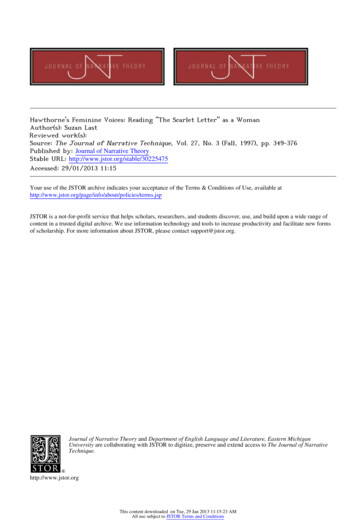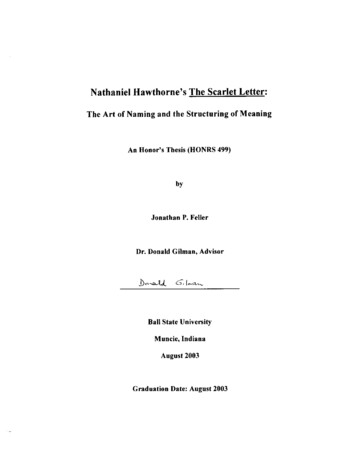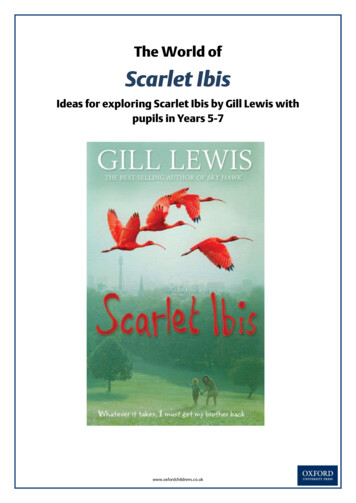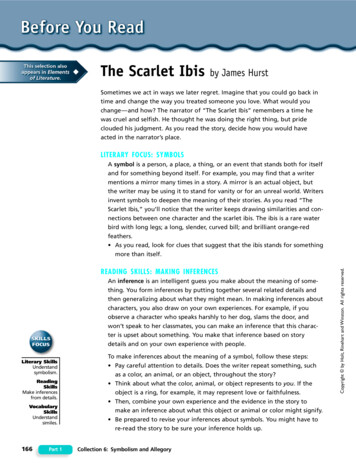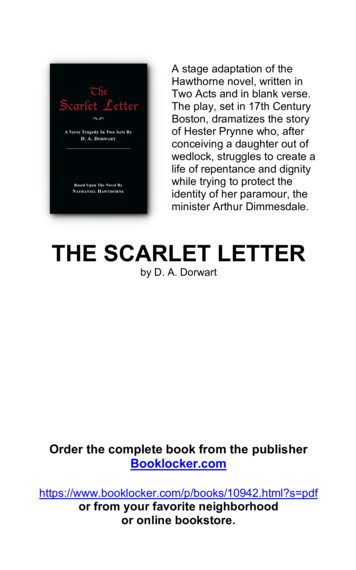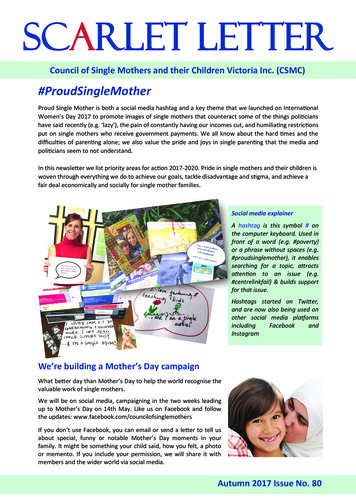
Transcription
SCARLET LETTERCouncil of Single Mothers and their Children Victoria Inc. (CSMC)#ProudSingleMotherProud Single Mother is both a social media hashtag and a key theme that we launched on InternationalWomen’s Day 2017 to promote images of single mothers that counteract some of the things politicianshave said recently (e.g. ‘lazy’), the pain of constantly having our incomes cut, and humiliating restrictionsput on single mothers who receive government payments. We all know about the hard times and thedifficulties of parenting alone; we also value the pride and joys in single parenting that the media andpoliticians seem to not understand.In this newsletter we list priority areas for action 2017-2020. Pride in single mothers and their children iswoven through everything we do to achieve our goals, tackle disadvantage and stigma, and achieve afair deal economically and socially for single mother families.Social media explainerA hashtag is this symbol # onthe computer keyboard. Used infront of a word (e.g. #poverty)or a phrase without spaces (e.g.#proudsinglemother), it enablessearching for a topic, attractsattention to an issue (e.g.#centrelinkfail) & builds supportfor that issue.Hashtags started on Twitter,and are now also being used onother social media platformsincludingFacebookandInstagramWe’re building a Mother’s Day campaignWhat better day than Mother’s Day to help the world recognise thevaluable work of single mothers.We will be on social media, campaigning in the two weeks leadingup to Mother’s Day on 14th May. Like us on Facebook and followthe updates: www.facebook.com/councilofsinglemothersIf you don’t use Facebook, you can email or send a letter to tell usabout special, funny or notable Mother’s Day moments in yourfamily. It might be something your child said, how you felt, a photoor memento. If you include your permission, we will share it withmembers and the wider world via social media.Autumn 2017 Issue No. 80
SCARLET LETTERBi-annual newsletterCirculation 2600ARN: A0014618WAddress: Level 1, QVWC210 Lonsdale StMelbourneAdmin: 03 9654 0327W: www.csmc.org.auF: www.facebook.com/councilofsinglemothersT: @CSMCVICCEOJenny DavidsonContact WorkersFiona CombeJacqui NgFinance WorkerAnnette AntolinoCommunication & PolicyAndi SebastianCSMC Support Line03 9654 0622Outside Melbourne1300 552 511 (mobilecalls at mobile rates)E: csmc@csmc.org.auCSMC acknowledges thatour office stands on thetraditional lands of theWurundjeri people. Werespect their relationshipwith country, recognisingthat culture is still vitallyimportant to Wurundjeripeople today.This is your newsletterYou can: tell a story share or write anarticle find or draw a cartoon write a book review send in photos help with the mailoutSend contributions via: csmc@csmc.org.au or Level 1, QVWC210 Lonsdale StMelbourneAll contributions toScarlet Letter representthe views of theindividual author andmay not represent theofficial position of CSMC.From the CSMC Support LineIf you have called our Support Line, you will have spoken to Fiona or Jacqui. Eachday, our Contact Worker answers up to 20 phone calls and emails. Questions canbe quick, like: Is there a single mother support group in my area? or complex:How much time should my 12-month-old spend with his dad? We get calls aboutparenting, loneliness, juggling work, stretching money, housing, Family Court orCentrelink etc. Sometimes callers just need to talk and be listened to.Christmas to February are busy times for the Support Line as families strugglewith the expenses of Christmas, holiday activities and going back to school, andwith the difficult issues many separated families often face at this time of year.This year, government cuts to the School Kids Bonus made a huge dent in singlemothers’ ability to pay for school costs: fees, uniforms, shoes, IT devices, camps,books, swimming lessons, excursions and stationery. Callers expressed shock atrising costs of public education and sought financial assistance to buy necessaryitems. Many didn’t know about the available options for dealing with costs. OurBack to School Assistance Program helped 82 families with high school expensesat the start of 2017. We provided information and support to deal with issuesabout children’s access to education, and to find and access other supports.To talk to a Contact Worker, call 03 9654 0622 or 1300 552 511(outside Melbourne) 9.30am-3.00pm Monday-Friday. If youcan’t ring in these times, leave a message or emailcsmc@csmc.org.auTell us what you thinkWe are seeking feedback from individuals and organisations who have used ourservice. Go to: www.surveymonkey.com/r/CSMCSURVEY2016 and complete ourshort (5 minute) survey before 30th April for your chance to go into the drawto win a 50 Dymocks gift voucher. We will use the information to improve ourservice and to better advocate for single mother families.SCARLET LETTER - looking to the futureGoing onlineThank you to those keen to receive the newsletter via email to save trees andcosts. Most members still want a printed newsletter in the mail, so we continueto will print and post it to most members. We will send a PDF copy via email that can be read on-line or printed outonly to those that prefer it. When enough people want it via email, we willredesign it for online reading. Let us know if prefer email: csmc@csmc.org.au Beginning with this issue of Scarlet Letter, we will begin posting our newsletter on our website some months after members receive it. This will createan online archive that is accessible to many more single mothers.Rethinking the name of the CSMC newsletterScarlet Letter was originally the name of the newsletter of the National CSMC. InJuly 1977 when NCSMC could no longer afford it, CSMC Victoria agreed topublish and distribute it as a joint newsletter. NCSMC now puts their news onlineso we are thinking it may be time to reclaim the newsletter as solely ours andrefresh its identity. Any ideas for a new name? Please share your views via letter,phone or email to csmc@csmc.org.au.2
CEO’s spotMy first nine months as CEO have flown by with exciting achievements for the organisation and politicalbattles to protect the income of single mothers.The biggest change for Council of Single Mothers and their Children Vic is our new logo and branding,which you see revealed here. We have used Australia’s wedgetail eagle as a symbol of single mothers’strength, vision, capability and protective nature. Female eagles are larger than males, too!Our website has also been redeveloped and I encourage you to visit www.cscm.org.au. It is packed fullof information helpful to single mothers. If you have questions arising from the content or anycomments on the site, call our Support Line or email csmc@csmc.org.auI am proud to have worked with the Board and staff to create our StrategicPlan 2017-2020. It sets out the priorities for single mother families that wewill fight for over the next three years. These are: Secure income Diverse employment and education opportunities thatcomplement family responsibilities Safe, affordable and appropriate housing Legal protection in family law matters Wellbeing and resilience of single mothers Children’s wellbeingYou can view the Strategic Plan 2017-2020 on our fabulous new website!We have been advocating against cuts to welfare benefits that would disproportionately effect singlemother families, together with the National CSMC and many community organisations. These cuts wererolled into the ‘Omnibus Bill’ that the Government has been repeatedly introducing to Parliament sinceJuly 2016. An amended version of the Bill finally passed in March, with some mostly positive changes tochildcare. Childcare is the only good news unfortunately. We were disappointed that our collectiveefforts served only to limit the damage. Some of the changes passed will have financial repercussionsfor single mother families; see In the Loop (page 5) to find out more.I look forward to rolling out our Strategic Plan and applying ourselves over the next three years toimproving the circumstances of single mother families in Victoria and beyond.Jenny DavidsonIn this issue2. From the Support LineScarlet Letter changes7.CSMC Christmas Party photos3. CEO’s spot8.Insurance and low income earners4. Interview with Trace Balla9.Cutting corners - members tips5. Single mother creativity and persistenceIn the loop10.Letter from a member6. Bankruptcy - is it a good option?11.Getting work or getting back to workSingle mother enterprisesVale Rebekah Thomas3
Interview with Trace Balla - member, author, illustratorTrace, you first sent us your illustrations in 2002. What was happeningin your life then and where did you want your work to go?My son Joe was 2 and our lives were in upheaval. We had movedinterstate and it took a while until we had a stable home. We were quiteisolated and unsupported, so it was great to discover Parentlink and theCouncil of Single Mothers. Before I had Joe, I worked as an illustrator andanimator and hoped to illustrate children’s books, but it was hard to geta foot in the door. So I started to make my own books and self-publish.First they were travel and nature journals, and then I made stories for Joe. One book was to help him instarting sleepovers at his dad’s when he was about 4. I hope that will be published one day. I wrote Shinefor my niece and nephew (2 and 4) after the sudden death of their father and it has been published byAllen and Unwin. Another book for my son came out of playful dinner conversations. The Thank You Dishis also being published by Allen and Unwin and will be released in April this year.What has been key in getting to where you are with your work now?I’m lucky to have work that fits school and childcare hours. I applied for funding for developing children’sbooks and got it. When I went to a workshop to improve my skills, I was the only one who showed up. SoI took the tutor to lunch and quizzed him about working on my story, which later became Rivertime. Hewas impressed and introduced me to my publisher at Allen and Unwin. She liked what I was working onand that, with the pile of books I had made for my son. helped convince her to back me. I think that isthe key, that I was doing what I loved, regardless of making money from it. Each time I made a book Ilearnt more and it improved my work. Rivertime got a lot of recognition and I later made a sequel calledRockhopping set in Gariwerd (the Grampians). Having a few different work skills helped me to gain parttime and project jobs.I moved out of the city to central Victoria when my son was in grade four. Now I am working on a bookabout a girl who lives in a country town and connects with the community and nature. I visit schools andfestivals giving talks and workshops, which is a wonderful contrast to my often solitary work.What were some of the most helpful things to you as a single mum I love being a mother, but being a single mum is a tough gig! Little things stand out, like a meal left whenI bought my son home from hospital after an illness, and exchanges. A friend who lived in a van wouldbring round his washing and take a shower. In exchange he’d babysit and his company playing Lego andfooty with my son when I was around was gold to us. A girlfriend and I met each week, swappingbetween houses. The boys would play and us mums would take turns going out for a couple of hours tohave a swim or yoga or shopping for both of us. Then we would share lunch.I used to go dancing on Sunday mornings. My boy would wear headphones and take his books anddrawing things. People loved him coming and he grew up around dance. Parentlink used to run familycamps. I mostly went so I didn’t have to cook, but I ended up meeting some lovely locals, and we’d meetup on Friday nights and cook up a big pot of food while the kids played and we chatted. Then we hadenough leftovers to all take some home for a night off cooking which I was always happy about!Now I have a partner, and my son is 17. I have close friends who aresingle mums, and having some understanding of isolation, and beingaware of how those little things were so helpful, I think has enabledme to be a better friend. I love to help out with their kids and sharemeals together. I like to spell compassion comp-ASH-on If you getburnt, you can gain a lot of compassion.To see Trace’s work, go to: authors/b/trace-balla4
Single mother creativity and persistenceBelieve: To all the single mothers who believed in me I wrote these words because I believe in you!Believe you will come to have a better dayBelieve that your children will grow to be okayBelieve people care for you more than you knowBelieve your children love you much more than they showBelieve that in the future the sun will shine brightBelieve that soon your children will sleep tight at nightBelieve your challenges will make you strongBelieve your children will know what it is to belongBelieve other single mothers are there by your sideBelieve as your children become adults they’ll think of your courage with pride.Many thanks to TS - ‘Single mother for 12 ½ years to a beautiful 13 ½ year-old boy’ for this poem.In the loopCentrelink Robo-debt - Data systems of the Australian Tax Office and Centrelink are beingcross-matched by computers without human interpretation. Thousands of Australians have receivedletters saying they owe Centrelink money and in some cases, putting them straight in the hands of debtcollectors. The community sector has protested and a Senate Inquiry is looking at what happened, why,and how to prevent it happening again. If you have received a debt letter or have questions or want toknow how to respond, ring our Support Line 03 9654 0622 or outside Melbourne 1300 552 511.Submissions - CSMC is committed to bringing the lived experience of our members and callers to government decision making. On our website under Publications you can find our recent submissions on: Improving the Family Law Act (to accommodate family violence and have the Courts function better) Proposed ‘Reforms to Human Services’ to make them more competitive The Fairer Paid Parental Leave Bill An audit of child supportWhat’s on your Facebook page? - A lot of people are discovering Centrelink, other governmentdepartments, employers and even some doctors are using social media to check up on people. Thegeneral advice is only post what you are happy with any member of the public seeing.Seven big changes to FTB, Parenting Payment, Youth Allowance and Child Care changes are:1)Family Tax Benefits are being frozen at the current rate for two years.2)A new one week waiting period for Parenting Payments and Youth Allowance is being introduced.3)The financial hardship exemption from waiting periods is being abolished. There is still anexemption for domestic violence.4)Parenting Payment and Newstart income-free limits are also frozen. This means people workingand still getting some benefits will see those benefits fall in value over the next few years.5)Child Care Benefit and Child Care Rebate will be rolled into one child care payment and thesubsidy increased to 85% of the full cost of child care.6)Removal of the 7,500 annual cap on child care payments. There is now no cap for almost allfamilies. This is a big victory for thousands of working families.7)The base level of subsidised child care is 12 hours per week with no activity test.You can find full details on the website singlemum.com.au5
Bankruptcy - is it a good option?Bankruptcy worked for Donald Trump’s companies four times.Would it work for you?The answer to this varies depending on circumstances: whether you have apersonal net worth of 2.7 billion and a string of over-leveraged casinos and hotelsthat you need to “restructure’, or you are a person notified by Centrelink that youowe a robo-debt, or a single mum temporarily unable to work due to illness.You might be considering bankruptcy as a way to manage debt, or someone mayhave suggested it to you, or threatened you with it. There are three pieces ofadvice that you should take – just like Donald Trump’s companies did – before youmake the decision to go bankrupt: Don’t panic, take your time, and make the decision that is right for you; Make sure you understand how bankruptcy could affect your life; and Get help, use the free resources available, then make your own decision.What is bankruptcy?Bankruptcy is a status that a person enters, either voluntarily or involuntarily, if they cannot pay theirdebts from their available income and assets. The period that a person is bankrupt is usually 3 years.Becoming bankrupt means that: You do not have to repay debts you had at the time you became bankrupt; People to whom you owe money (creditors) cannot take action to recover debts from you anymore; A trustee is appointed to manage your estate and property you have may be used to repay creditors; Transactions entered into just prior to your bankruptcy may be declared “void”; You will have to pay a proportion of your income to your creditors for at least 3 years; If you receive money such as an inheritance during the period of bankruptcy, then (with certainexceptions) it will be used by the trustee to repay your creditors; The fact you have been bankrupt will be permanently recorded on a public register; You will not be able to do certain things (e.g. obtain credit, holiday overseas) while you are bankrupt; If you own your home solely or jointly, or are repaying a mortgage loan to purchase a home, youmay not be able to keep your share of the house; and After being discharged from bankruptcy, you will have to disclose that you have been bankrupt tobanks, credit providers, and some professional associations.How do you become bankrupt?Voluntary bankruptcy - You may decide to become bankrupt by presenting a “debtors petition” to theAustralian Financial Security Authority. You do not need to go to court. Only do this after considering ALLyour options and getting advice from a professional financial counsellor or a reputable free service. Youcan become bankrupt if you owe 5,000 or more, but if you owe less than 10,000 to just one or twocreditors, consider other options, both formal and informal.Involuntary bankruptcy - A creditor may “petition” for your bankruptcy if you owe creditors a total ofmore than 5,000. This process usually starts with a creditor serving a “Bankruptcy Notice” on you, andconcludes with the court making a “sequestration order” and appointing a trustee to manage yourbankrupt estate. You do not have to attend court but you are entitled to do so. You do not need to havea lawyer to attend court, but if you want one free of charge, it must be arranged beforehand.What should you do if someone you owe money to threatens to bankrupt you?Bankruptcy is not supposed to be used as a method of debt collection. It is also not meant to be apunishment for financial distress. Often, bankruptcy occurs because people don't explore informaloptions for resolving their debts, such as negotiating a payment plan, or applying to have debtswaived or written off under hardship policies.6
If a creditor wants to serve you with a Bankruptcy Notice, they must first obtain a“judgment debt” against you. This official court order shows the creditor has provenyou owe them a particular amount of money. Sometimes creditors send a letter ofdemand, or a notice that you owe them a debt. This is not enough to start the bankruptcy process. The creditor needs to go to court to obtain a “judgment debt” first.Alternatives to BankruptcyUnder the Bankruptcy Act 1966, there are two formal alternatives to bankruptcy, called a “PersonalInsolvency Agreement” or a “Debt Agreement.” Information about these options is on the AustralianFinancial Security Authority website: www.afsa.gov.auOther methods of managing debt, such as hardship registers, may help you deal with pressure fromdebt collectors, and free support is available to access these: National Debt Helpline: http:www.ndh.org.au National Hardship Register: www.nhr.org.auHave you seen advertisements offering “government funded” programs to help you get out of debt, orservices to help you manage your household budget? You will have to pay for these. Free services areavailable, such as the ones mentioned in this article. Some companies such as banks and utilities, havespecial policies on financial hardship for their customers.If your issue is with Centrelink, you have the right to free, independent reviews of decisions aboutincome support payments and benefits. So, before you decide to become bankrupt because you have anotice from Centrelink that you owe a debt, seek assistance from a specialist service to help youunderstand how much money you owe, and what steps you can take to deal with the situation: National Social Security Rights Network: www.nssrn.org.au/services Social Security Rights Victoria: www.ssrv.org.auCommunity legal centres can help you understand your situation and assess whether bankruptcy is theright option for you. Find your nearest one at: www.communitylaw.org.auThanks to Robyn, a solicitor and CSMC member, for this article.Many thanks to the volunteers and donors whocontributed to our successful Christmas party7
Insurance and low income earnersMany low income families, including single parents, struggle to work out whether it is worth paying forinsurance policies for their home, their contents and their car. Many policies are unaffordable, withexpensive annual premiums and high excesses if you make a claim. Most insurance companies prefer asingle annual payment for the policy or offer monthly payments which can still be expensive andimpractical. Here are some hints that may help.Financial HardshipMany insurers have introduced measures to assist people in financial hardship. Insurers can help withmonthly payments rather than a single yearly payment, or allow you to pay the excess off over a three orsix month period. There are products being created to cater for people on low incomes. The Insuranceindustry has a Code of Practice which includes a section on financial hardship.Good InsuranceGood Shepherd Microfinance’s “Good Insurance program” works with Australia’s largest insurancecompanies to create affordable and simple insurance policies for people on low incomes. These productsenable people to insure their household belongings or cars, so they’re protected if things go wrong.Insurance policies developed with Good Insurance: Are designed for the customer have affordable premiums with no or negligible excesses, and have flexible payment options available.Essentials by AAI, developed by Suncorp, is a Good Insurance product that allows customers tocomprehensively insure their car, their home contents or both. Customers can choose to pay premiumsannually, or in monthly or fortnightly instalments, and can use Centrepay to manage payments. You maybe eligible for this product: If you have a healthcare card receive Centrelink payments, or have a household income of 48,000 or less (excluding superannuation).Visit www.essentialsbyaai.com.au or ask Good Shepherd Microfinancewww.goodshepherdmicrofinance.org.auCar InsuranceComprehensive insurance may not be worthwhile if your car is worth less than 7000. Low value carscan be insured with third party insurance which covers the other driver if you have an accident and ischeaper. Third party will NOT cover your car if you are at fault, which leaves you to pay for repairs orhaving to replace your car. Many people do not realise that third party insurance includes the UninsuredMotorist Extension that will cover your car for up to 5000 if you are not at fault and the other driver isuninsured.Essentials has a product designed for low income consumers with low value cars. It allows you tocomprehensively insure your car for up to 5000 and pay fortnightly with no excess on claims. If you arein an accident and you are uninsured or only have third party, see your local community legal centre.They can negotiate with insurers and lawyers and may be able to get you out of a debt if you are infinancial hardship. If you are currently paying for a motor car accident where you were at fault, youshould definitely visit a legal centre for advice.Tenants and ContentsMany tenants decide it is not worth insuring their contents. However with more low income familiesliving in rural and regional areas there is a greater risk of losing everything in a fire or flood. There arenow policies for tenants which have a lower amount insured, and policies that allow you to cover just afew items like the refrigerator or electronic devices. Again Essentials will provide really good value andaffordable contents insurance.8
If you are a tenant and have an accident with a fire in the kitchen or a flood in the bathroom, or yourex-partner damages the property, seek advice from a legal centre. Many insurers will agree not to askyou to pay damages if they know you are in financial hardship.Your homeAfter a break up some women feel they cannot afford to continue to pay forinsurance on their home. If you are in this situation, see a financial counsellor andfind a way to pay for home insurance. If your home is damaged by a fire or floodyou may be left with an expensive mortgage that is worth more than yourproperty. This is a big risk!Thanks to Denis Nelthorpe, Chief Executive Officer at WEstjustice Community Legal Aid for this article.Cutting corners - member tipsTanya D.With the government getting tougher on single parents it’s good to have extra resources up our sleeves.The Queen’s Fund offers grants up to 350 every two years to disadvantaged women. These are paiddirectly for things like rent and rates. To apply, you need to book an appointment with a financial counsellor (Salvation Army and Anglicare are free) and tell them you want to apply for the Queen’s Fund.They can do this online with you or you can print out the form and bring it with you. I found their website helpful: www.queensfund.org.auBills and the Utility Relief Grant Scheme - Swamped with bills? You can apply for this government grantup to 500 every 2 years for EACH of your utility bills, gas, water and electricity. To access the grant ringyour utility provider, ask to speak to the hardship team and tell them you want to apply for the grant.They will send the paperwork out to you. If your bill is under 500 most utility companies let your debtreach 500 before you apply so you can get maximum benefit from the Grant. Just ask.Are you or your kids at university or TAFE? Most tertiary institutions offer scholarships, many fordisadvantaged women or children from low-income families. Usually you just need to be a health carecardholder. It’s worth spending time applying for scholarships. Don’t be put off thinking you won’t getone, as many don’t get a lot of applicants. Scholarships can cover a laptop grant, fee help, materials andbooks. Get onto your TAFE or university’s homepage and search and apply. Also many offer financialhelp such as an interest free loans, cash grants, MYKI cards and food vouchers.MaureenGood at managing your money and want a loan? The NILS scheme stands for a No-Interest LoanScheme and runs across Australia, providing individuals and families on low incomes with access to safe,fair and affordable credit. You can find out all about it online: nils.com.au or ring NILS 136 457. Loans areusually from 300- 1200 for things like washing machines and medical expenses.Write a lot of letters? With a concession card, you can set up a free MyPost Concession account andget 5 free stamps and additional stamps at a cheaper rate.Not good at managing money? Check Community Centres for cheap or free ‘how to budget’ courses.RobynThe Women's Legal Service is great: womenslegal.org.au 03 8622 0600 or 1800 133 302AlexaI’m a single mum and a member of a housing co-op which gives me so much housing security.I contacted my energy provider after looking at comparable plans and got them to better the savingsrates with one email and a phone call to accept the offer. Simply Energy have a deal for RACV membersMy new plan means a 42% saving on energy and a 28% saving on gas. I am so pleased as this haslowered my costs significantly.9
Letter from a memberI have enjoyed reading your newsletter for about 16 years now.It is hard to summarise my story, but here goes:I separated from my husband when I was four weeks pregnant with our fourthchild. It was the best thing I ever did as he was emotionally and physicallyabusive. It has been a hard slog, raising four children alone and strugglingfinancially, but it also meant that I started to live again. I was finally FREE of hisdaily put downs, emotional attacks and abuse. He dragged me through the FamilyCourt that year while I was pregnant. It was awful. Things did settle down though.My children are now aged 26, 23, 20 and 16. The three youngest still live athome. None of them want anything to do with their father.I have managed to hang on to my home. In divorce settlement he kept his superannuation and I got amassive mortgage! Somehow I have managed to pay it although I have been behind with repayments afew times and feared I would lose the house. The bank gave me the mortgage based on the childsupport I was supposed to receive For a few years I received no child support at all, while he workedand earned a good income. It is a disgrace that the Child Support Agency have very little power to doanything. I know there are lots of good separated/divorced dads who do the right thing but somefathers steal from their own children by hiding their income to avoid paying child support. I don't feelbitter. I chose (a partner) badly, and stayed too long in the relationship, thinking somehow, if I triedharder, it would work.I have learned a lot. I always planned to go back to university, but have not been able
Scarlet Letter represent the views of the individual author and may not represent the official position of SM. This is your newsletter You can: tell a story share or write an article find or draw a cartoon write a book review send in photos help with the mailout Send contributions via: csmc@csmc.org.auor Level 1, QVW

